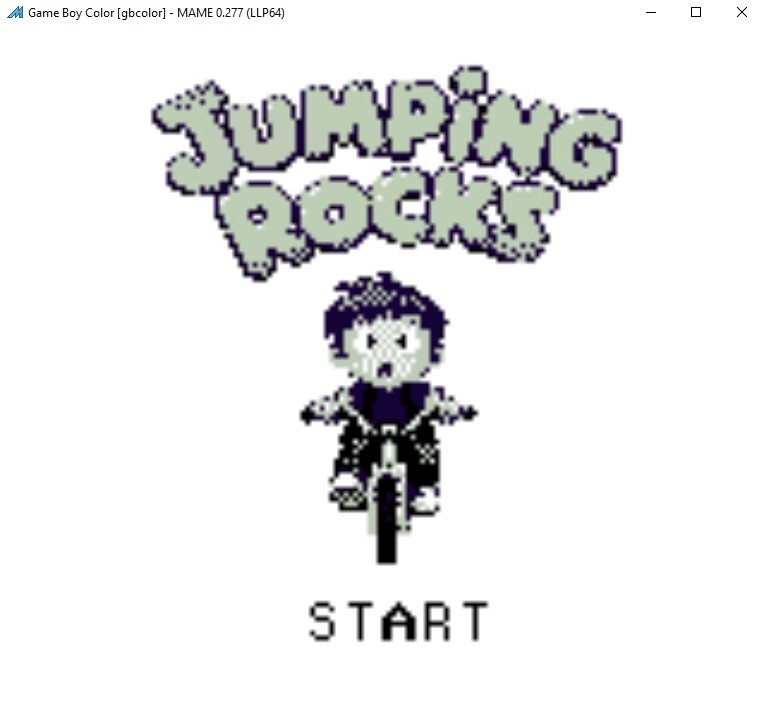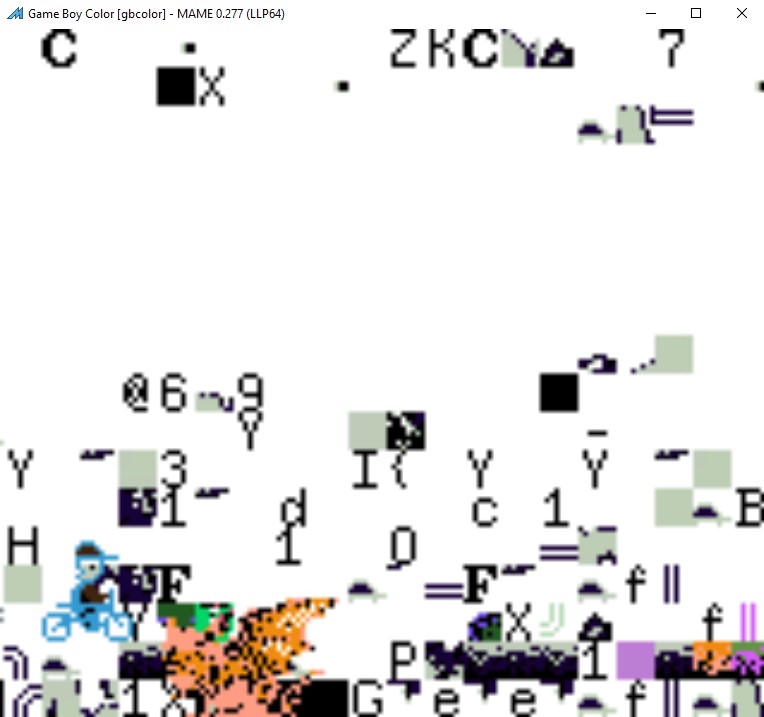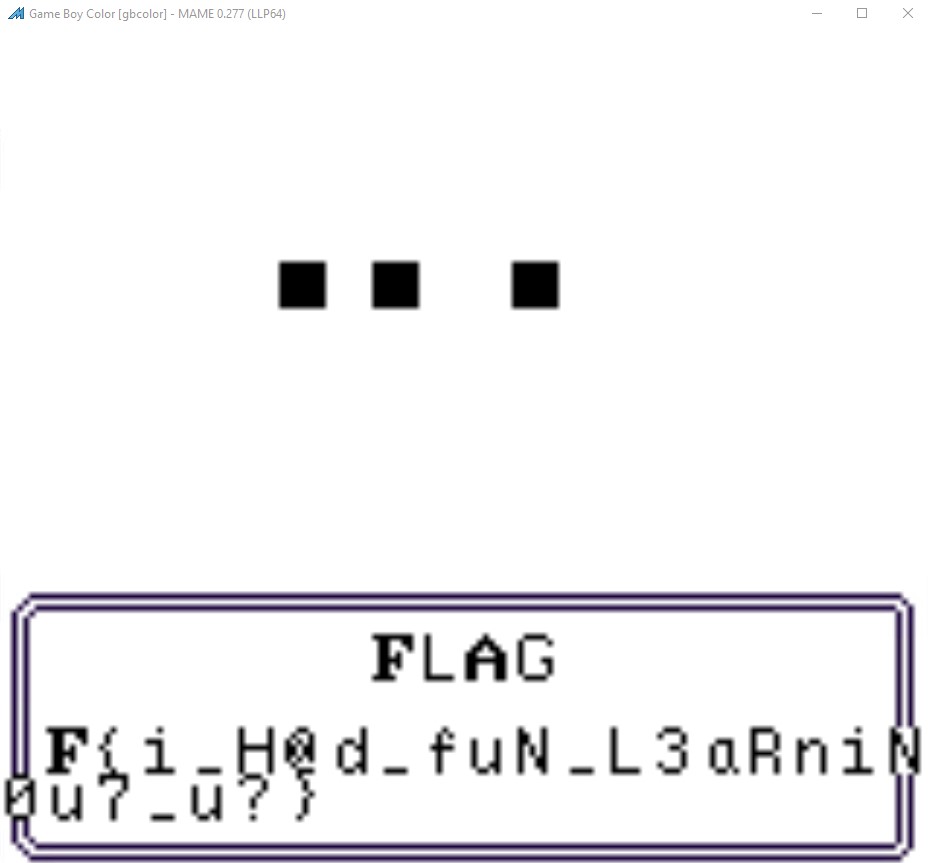CGB
ℹ️ Part of this analysis is done post CTF.
CGB was one of the reversing challenges from Google CTF 2025. It was solved by 23 teams and during the CTF I did mange to get part of the solution but not the final flag. After the CTF, with a bit more time, I attempted to solve it, and here’s a writeup.
The task description reads:
A game I found in a developer’s drawer, it looks like an unfinished game about a character jumping rocks?
and we are given an attachment that contains the following files
├── README.md
├── hash
│ └── gbcolor.xml
└── roms
├── gbcolor
│ ├── gbc_boot.1
│ └── gbc_boot.2
└── gctf
└── gctf.gb
Checking the README.md, we can see extra information about how we can run the game.
I don’t have a console with me, but you can emulate it with MAME:
$ /usr/games/mame -hashpath hash -window -rp roms gbcolor gctf
Let’s boot up the game and see what it’s about.
When starting the game we can see a main screen

and after pressing start we can start it

but after a while, the game stops and displays garbage on screen.

From the MAME documentation, we find that adding -debug to the command line we can run it with a debugger. That will be handy for sure.
Let’s see what’s inside it using Ghidra.
Static analysis
Ghidra by default is not able to load gctf.gb file but we can install an extension GhidraBoy. With that, it’s still recognized as Raw bytes, but we can pick a Sharp SM83 CPU as language which is what we need for this ROM. That’s the one that’s used in Game Boy Color.
The file is loaded but not much analysis is performed and no memory maps are automatically created. We can overcome that consulting with the specification - I’ve used gbdev.io. We can find there info that, in case of a ROM, the start address is at address 0x150 - we can navigate there and press d to convert bytes to code.
As for the memory maps, the documentation also helps here and we can quickly create a couple more regions
| region name | start | end |
|---|---|---|
| ram | 0x0000 | 0x7fff |
| video_bank | 0x8000 | 0x9ffe |
| work_ram | 0xc000 | 0xcffe |
| work_ram2 | 0xd000 | 0xdffe |
| OAM | 0xfe00 | 0xfe9e |
| io_controls | 0xff00 | 0xff7e |
Thanks to that, we won’t be dealing with errors that some references are not defined. Also thanks to the documentation we can give specific locations more meaningful names. Instead of 0xff40, we can use LCD_Control, and 0xff41 is LCD_Status.
The code that starts at 0x150 is basically the main loop of the game.
Having more meaningful names is helpful as we can identify functions where some input is accessed. Such function is one at 0x228 (check_for_key). It reads the joypad input (0xff00) twice, first selecting the d-pad to be read
0234 3e 20 LD A,0x20 ; select d-pad
0236 77 LD (HL=>joypad_input),A
0237 7e LD A,(HL=>joypad_input)
0238 2f CPL
0239 e6 0f AND 0xf
023b cb 27 SLA A
023d cb 27 SLA A
023f cb 27 SLA A
0241 cb 27 SLA A
0243 47 LD B,A
and then shifting the 4 lower bits to be the top 4, and then reading the buttons
0244 3e 10 LD A,0x10 ; select buttons
0246 77 LD (HL=>joypad_input),A
0247 7e LD A,(HL=>joypad_input)
0248 2f CPL
0249 e6 0f AND 0xf
024b b0 OR B
and OR-ing them together.
So after those operations the A register will hold:
| A-value | key pressed |
|---|---|
| 0x80 | Down |
| 0x40 | Up |
| 0x20 | Left |
| 0x10 | Right |
| 0x08 | Start |
| 0x04 | Select |
| 0x02 | B |
| 0x01 | A |
And if we follow the logic at the end of this function, it seems to be storing the inputs in the buffer located at 0xc001 and 0xc051. When new input is detected, the old buffer is shifted to make room, and the new key is placed at the end. Also the last key is available as a value at memory 0xc000.
This function is called from 3 places: 0x1c0, 0x1e2 and 0x220.
The first two are directly in the main_loop. The first instance is to wait for a start key on the main screen - which is obvious having the current knowledge of the program:
wait_for_game_start:
01c0 cd 28 02 CALL check_for_key
01c3 fa 00 c0 LD A,(input_key)
01c6 fe 08 CP KEY_START ; 0x08
01c8 20 f6 JR NZ,wait_for_game_start
The second one is at 0x1e2 and just after that there’s a function 0x5b9 where the input at 0xc001 is compared with the following values [0x01, 0x02, 0x10, 0x20, 0x10, 0x20, 0x80, 0x80, 0x40, 0x40] and if we map it to the keys we get [A, B, Right, Left, Right, Left, Down, Down, Up, Up] which is Konami code in reverse.
If we try that during the game we are presented with the next screen.

Some progress, but the flag is not there yet.
The full function in question:
undefined check_konami_code()
05b9 f5 PUSH AF
05ba c5 PUSH BC
05bb d5 PUSH DE
05bc e5 PUSH HL
05bd 21 40 4d LD pKonami,konami_keys
05c0 11 01 c0 LD pInput,input
05c3 0e 0a LD C,0xa
05c5 1a LD A,(pInput=>input)
05c6 be CP (pKonami=>konami_keys)
05c7 20 0d JR NZ,no_konami_code
05c9 23 INC pKonami
05ca 13 INC pInput
05cb 0d DEC C
05cc 20 f7 JR NZ,keep_checking
05ce e1 POP pKonami
05cf d1 POP pInput
05d0 c1 POP BC
05d1 f1 POP AF
05d2 e1 POP pKonami
05d3 c3 1d 02 JP konami_code_accepted
So we should continue konami_code_accepted at address 0x21d.
The function at 0x21d is quite simple
undefined konami_code_accepted()
021d cd a5 02 CALL show_flag_screen_after_konami
LAB_0220:
0220 cd 28 02 CALL check_for_key
0223 cd 5d 03 CALL FUN_035d
0226 18 f8 JR LAB_0220
We need to check the function located at 0x35d. That one is also not very interesting, but the function it calls located at 0x369 is.
undefined FUN_0369()
0369 f5 PUSH AF
036a c5 PUSH BC
036b d5 PUSH DE
036c e5 PUSH HL
036d cd d3 02 CALL FUN_02d3
0370 cd 70 04 CALL FUN_0470
0373 cd fc 02 CALL FUN_02fc
...
If we check those three functions, their functionality is as follows:
Starting from the top:
- copy our input buffer from
0xc052to0xc029and transform it - copy the transform data from
0xc052to0x99e1 - compare the transformed data from
0xc029with a predefined buffer located at0x52b7
We can start from the bottom.
The compare function is quite straightforward:
undefined FUN_02fc()
02fc f5 PUSH AF
02fd c5 PUSH BC
02fe d5 PUSH DE
02ff e5 PUSH HL
0300 21 29 c0 LD HL,prepared_data_c029
0303 11 b7 52 LD DE,final_data
0306 0e 28 LD C,0x28
LAB_0308
0308 1a LD A,(DE=>final_data)
0309 47 LD B,A
030a 2a LD A,(HL+)=>prepared_data_c029
030b b8 CP B
030c 20 18 JR NZ,data_do_not_match
030e 13 INC DE
030f 0d DEC cnt
0310 20 f6 JR NZ,LAB_0308
The final_data is:
0x1c, 0x17, 0xc7, 0x11, 0xc0, 0xc6, 0xc5, 0x85, 0xa3, 0x57, 0x9d, 0xf1, 0xb2, 0xae, 0x01, 0x51,
0xe0, 0xf5, 0x18, 0xb1, 0xaf, 0x7f, 0x13, 0x32, 0x39, 0xeb, 0xe6, 0x26, 0x96, 0x26, 0x8b, 0xaa,
0x1f, 0x23, 0x00, 0x37, 0x86, 0x7a, 0x8d, 0xbc
and if all the bytes matches we do execute some more functions but for now we need to find out what would give us those final bytes.
The middle function seems to be responsible for displaying our input to the screen so it will probably show the flag instead of the empty space we saw previously.
undefined FUN_0470()
0470 f5 PUSH AF
0471 c5 PUSH BC
0472 d5 PUSH DE
0473 e5 PUSH HL
0474 21 e1 99 LD HL,DAT_99e1
0477 11 52 c0 LD DE,DAT_c052
047a 0e 28 LD C,0x28
LAB_047c
047c 1a LD A,(DE=>DAT_c052)
047d cd 30 00 CALL VRAM_accessible
0480 22 LD (HL+),A
0481 13 INC DE
0482 0d DEC C
0483 20 f7 JR NZ,LAB_047c
0485 e1 POP HL
0486 d1 POP DE
0487 c1 POP BC
0488 f1 POP AF
0489 c9 RET
so that leaves us “only” with the first one. We need to understand how we get the correct bytes into our buffer so that later they are displayed on the screen by the FUN_0470 routine and compared with the final ones inside FUN_02fc.
Function FUN_02d3
This one is the most complex one from all of those before so it is justified to give it a separate chapter.
The function starts with yet another data copy, and then we call another function on our buffer.
02e3 21 29 c0 LD HL,prepared_data_c029
02e6 11 7d c0 LD DE,DAT_c07d
02e9 0e 00 LD C,0x0
LAB_02eb:
02eb cd 27 53 CALL decode_flag
02ee 23 INC HL
02ef 23 INC HL
02f0 0c INC C
02f1 0c INC C
02f2 79 LD A,C
02f3 fe 28 CP 0x28
02f5 20 f4 JR NZ,LAB_02eb
We operate on 2 bytes and call the decode_flag function until we reach 0x28. So what’s going on inside decode_flag?
This part isn’t entirely clear to me, but it seems that we are loading some color values. First part of the function populates 0x99e1 with the values 07 01 00 05 04 03 06 02 07 00 01 05 03 04 02 06 00 07 05 01 03 04 06 02 07 00 05 01 03 04 02 06 07 00 01 05 (those are defined in gbc_boot.2) which seem to be palette numbers. Each number is shifted by 3 and used to load four color values associated with that palette.
5349 cd 30 00 CALL VRAM_accessible
534c fa 69 ff LD A,(BCPD_BGPD)
534f 12 LD (DE),A
5350 13 INC DE
5351 34 INC (HL)
5352 0d DEC C
5353 20 f4 JR NZ,load_4b
later we do the same but we pick next number from the list and we xor those values together. For example for the pair (7,1) we would get the following:
0x13 0x78 0xF7 0x69 (7)
0x7F 0x42 0x3D 0x0A (1)
and XOR-ing them together produces 0x6C 0x3A 0xCA 0x63.
This was only a preparation. Now the real work begins. Near the end of this function
5384 cd ef 52 CALL FUN_52ef
5387 cd 00 53 CALL FUN_5300
538a 0c INC C
538b 79 LD A,C
538c fe 10 CP 0x10
538e 20 f4 JR NZ,LAB_5384
5390 c1 POP BC
5391 f1 POP AF
5392 c9 RET
first we load the xored color value from the index stored in register C. We take it modulo 4.
Next, we do some byte and bit manipulation:
For each pair of input bytes (call them A, B), we perform the following 16 times:
- we take the B and do the
RLCAandRRCAbased on the bits of the xored color value - we xor the output of that with
Aand store it in atempvariable - we store B as a new A
- for the new B we put the calculated temp variable
In Python, we could write it as:
def shuffle_bits(A, B):
B &= 0xFF
C = 8
while C > 0:
if B & 0x01:
A = ((A << 1) | (A >> 7)) & 0xFF
else:
A = ((A >> 1) | (A << 7)) & 0xFF
B >>= 1
C -= 1
return A
def decode(ab, v):
ab_prim = list(ab)
for i in range(16):
b = v[i % 4]
a = ab_prim[1]
a = shuffle_bits(a, b)
tmp = ab_prim[0] ^ a
ab_prim[0] = ab_prim[1]
ab_prim[1] = tmp
return ab_prim
and we store those shuffled values as our new input. We repeat this process until all bytes are processed. And that’s the input that is compared with our predefined buffer at 0x52b7.
Finding the input is trivial now. We can check all the possible 2 byte pairs and see which one, after shuffling will give us the correct values.
idx = [
0x07, 0x01, 0x00, 0x05, 0x04, 0x03, 0x06, 0x02, 0x07, 0x00, 0x01, 0x05, 0x03, 0x04, 0x02, 0x06,
0x00, 0x07, 0x05, 0x01, 0x03, 0x04, 0x06, 0x02, 0x07, 0x00, 0x05, 0x01, 0x03, 0x04, 0x02, 0x06,
0x07, 0x00, 0x01, 0x05, 0x03, 0x04, 0x02, 0x06
]
def check_bits(A, B):
B &= 0xFF
C = 8
while C > 0:
if B & 0x01:
A = ((A << 1) | (A >> 7)) & 0xFF
else:
A = ((A >> 1) | (A << 7)) & 0xFF
B >>= 1
C -= 1
return A
def decode(ab, v):
ab_prim = list(ab)
for i in range(16):
b = v[i % 4]
a = ab_prim[1]
a = check_bits(a, b)
tmp = ab_prim[0] ^ a
ab_prim[0] = ab_prim[1]
ab_prim[1] = tmp
return ab_prim
vals = {
0: [0x03, 0x1c, 0x37, 0x5B],
1: [0x7f, 0x42, 0x3d, 0x0a],
2: [0x76, 0x5b, 0x61, 0x1c],
3: [0x2e, 0x79, 0x64, 0x11],
4: [0x40, 0x33, 0x58, 0x35],
5: [0x7a, 0x7D, 0x4c, 0x22],
6: [0x0f, 0x4a, 0x56, 0x65],
7: [0x13, 0x78, 0xf7, 0x69]}
keys = []
for k in range(0, len(idx), 2):
i = idx[k]
j = idx[k+1]
v1 = vals[i]
v2 = vals[j]
keys.append([(c1 ^ c2) for (c1,c2) in zip(v1,v2)])
final = [
0x1c, 0x17, 0xc7, 0x11, 0xc0, 0xc6, 0xc5, 0x85, 0xa3, 0x57, 0x9d, 0xf1, 0xb2, 0xae, 0x01, 0x51,
0xe0, 0xf5, 0x18, 0xb1, 0xaf, 0x7f, 0x13, 0x32, 0x39, 0xeb, 0xe6, 0x26, 0x96, 0x26, 0x8b, 0xaa,
0x1f, 0x23, 0x00, 0x37, 0x86, 0x7a, 0x8d, 0xbc ]
def search(part_flag, key):
for k in range(255):
for l in range(255):
candidate = [k,l]
res = decode(candidate, key)
if res == part_flag:
return candidate
return None
f = []
for i in range(len(final)//2):
part_flag = final[i*2:i*2+2]
key = keys[i]
c,d = search(part_flag, key)
f.append(c)
f.append(d)
print(f'Res? {[hex(x) for x in f[::-1]]}')
l = []
for i in range(len(f)//2):
part_flag = f[i*2:i*2+2]
key = keys[i]
a,b = decode(part_flag, key)
l.append(a)
l.append(b)
print(f'Correct? {all([a == b for (a,b) in zip(l,final)])}')
What it does it to first calculate all the color XOR values and store them inside keys. And then later find an initial value of bytes that when shuffled produce the expected result.
Running the script will give us the correct values ['0x4b', '0x4c', '0x37', '0x48', '0x44', '0x37', '0x3d', '0x0a', '0x47', '0x48', '0x39', '0x3d', '0x2a', '0x48', '0x0a', '0x0f', '0x25', '0x48', '0xf', '0x16', '0x2b', '0x30', '0x1a', '0x23', '0x40', '0x14', '0x48', '0x16', '0x37', '0x28', '0x48', '0x26', '0x47', '0x10', '0x48', '0x2b', '0x4a', '0x0e', '0x1c', '0x0b'].
But we’re still missing one piece: how do we input it, and where?
If we go back to the function that read the joypad input (0x228) if we detect that there was an input we call a few function and one of them is at 0x457. It’s not very lengthy, but it reads a value from 0xc07a.
undefined store_key()
0457 f5 PUSH AF
0458 c5 PUSH BC
0459 d5 PUSH DE
045a e5 PUSH HL
045b 21 7b c0 LD HL,cnt_00_ff
045e 4e LD C,(HL=>cnt_00_ff)
045f cb 21 SLA C
0461 fa 00 c0 LD A,(input_key)
0464 3d DEC A
0465 46 LD B,(HL=>cnt_00_ff)
0466 a0 AND B
0467 b1 OR C
0468 ea 51 c0 LD (DAT_c051),A
046b e1 POP HL
046c d1 POP DE
046d c1 POP BC
046e f1 POP AF
046f c9 RET
That value goes from 0x00 to 0xFF, and the current value is shifted left by 1 and OR-ed with the provided key. The computed value is what’s used in the subsequent calculations.
Now, I’m not sure if it’s possible to reliably input the correct values from within the game (since we don’t see the counter), but we can fake it. If we put a breakpoint at 0x468 we can set A to the correct value from our python script and it should be good.
Note: I did try to automate that part but it seems MAME isn’t quite there yet in that regard so there’s a bit of manual work required.
We can use bpset 0x468, press a key and then do A=<value from Python output>, and the flag should begin to appear.

Final flag: CTF{i_H@d_fuN_L3aRniNG_cGB_h0w_@B0u7_u?}
Challenge solved — and I definitely learned a lot about Game Boy Color internals along the way.